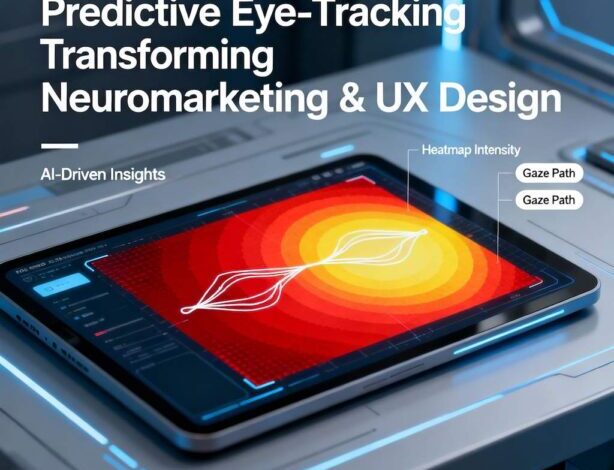How Predictive Eye-Tracking is Transforming Neuromarketing and UX Design

Marketers have long sought to understand which elements capture attention in the first seconds of exposure. Traditional methods like surveys and live eye-tracking deliver valuable data but are costly, time-intensive, and limited to small participant groups.
Brainsight.app uses predictive eye-tracking powered by AI to address these challenges, forecasting where users are most likely to look in the first 2–3 seconds of visual exposure—a stage called instant attention. The platform makes predictive attention analysis scalable and hardware-free, using models trained on large live eye-tracking datasets to replicate natural viewing behavior.
This allows creative teams to validate assets before launch, ensuring layouts are optimized for visibility and engagement. Marketers and designers can streamline design workflows, minimize guesswork, and allocate resources more effectively by predicting what captures attention first.
How Predictive Attention Works
Predictive attention models use visual saliency analysis, simulating automatic responses to shape, size, color, contrast, and position. Neuroscience research shows these reflexes are driven by the brain’s amygdala and brainstem (“lizard brain”), which instinctively fixate on salient elements before conscious interpretation.
Outputs include:
- Predictive heatmaps – highlight areas likely to draw the eye first.
- Gazeplots – show likely viewing order (e.g., logo → CTA → message).
Unlike live testing, predictive attention does not measure emotion, engagement, or bias. Instead, it offers probability-based visibility forecasts, helping teams quickly optimize design decisions.
Enhancing Advertising with Predictive Heatmaps
Ad effectiveness often hinges on whether critical assets—logos, brand names, or CTAs—are visible in the first few seconds. Research shows that achieving an attention score of 65 or higher is linked to +59% improvements in click-through rates (CTR) (Dentsu’s Attention Economy).
Brainsight’s predictive heatmaps allow advertisers to:
- Test campaign creatives before launch.
- Adjust layouts, hierarchy, and design elements to meet visibility benchmarks.
- Compare results against attention benchmarks for their channel or industry.
This pre-validation minimizes wasted ad spend and maximizes return on investment (ROI).
Important distinction: Predictive heatmaps forecast initial visibility, while tools like Hotjar or Microsoft Clarity measure actual behavioral engagement (clicks, scrolls). Together, teams gain a complete picture: predicted visibility + observed interactions.
Optimizing Website and UX Design
Predictive attention directly informs UX and conversion optimization. Gazeplots can reveal design sequences—such as whether a user notices a CTA before supporting content—and clarity scores highlight areas of clutter or distraction.
Key UX benefits include:
- Streamlined visual hierarchy for easier comprehension.
- Validation that CTAs and navigation elements are positioned for visibility.
- Designs that reduce cognitive load align with Nielsen Norman Group research on usability and reading patterns.
Clarity Scores measure information processing effort, offering actionable feedback to improve user flows.
The Role of Benchmarks and Clarity Scores
Benchmarks and clarity scores provide context for design performance:
- Attention benchmarks compare campaigns against peer datasets within the same industry or format.
- Clarity scores quantify cognitive ease, with fewer visual hotspots linked to higher retention and message recall.
These metrics provide creative teams with objective validation—helping prioritize design changes and justify decisions with data.
Applications Across Marketing and Design
Predictive attention is a versatile solution that supports:
- Ad pre-testing: Refine layouts for stronger first impressions.
- UX and CRO optimization: Validate user flows before coding or launch.
- Video post-production: Ensure visual focus in high-value scenes.
- Brand analytics: Verify logo and brand elements land in high-attention zones.
Predictive models close the loop when paired with behavioral analytics, removing guesswork and enabling confident, data-backed creative decisions.
Future of Predictive Attention in Industry
As predictive AI models advance, attention analytics will become more precise and embedded in MarTech workflows:
- Real-time predictive overlays in creative software.
- Expanded benchmarks for new media types (social stories, CTV).
- Integration with AR/VR environments, ensuring immersive design elements capture attention effectively.
Organizations adopting predictive attention early benefit from faster creative cycles, improved ad performance, and measurable ROI in the competitive attention economy.
Conclusion
Predictive eye-tracking offers marketers and designers a scalable, science-backed method for anticipating how audiences perceive visual assets within seconds of exposure. By pairing predictive heatmaps, clarity scores, and attention benchmarks, creative teams align campaigns and user experiences with human visual reflexes—not assumptions.
This approach transforms testing from reactive to proactive, ensuring every pixel serves a purpose in delivering measurable impact.




